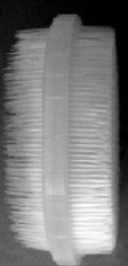|
Deep Pressure and Autism Deep pressure and Autism? What exactly does it mean? Many individuals with Autistic disorder desire pressure against their body. It tends to relax them when they feel overwhelmed. It is definitely a sensory issue although why people with Autism desire it is not 100% certain as of yet.
The Wilbarger technique uses a surgical scrub brush. See the picture below.

It is a non-scratching brush with many bristles made of molded plastic. The brush should not scratch the skin or too soft to deliver pressure in which cases it should not be used. Use the brush on the surfaces of the arms, hands, back, legs and feet. The brush should be held horizontal to the body with your fingers applying pressure across the entire surface of the brush. The arms, hands, back, legs and feet should be brushed with long even strokes in an up and down motion. Be sure to use firm pressure when brushing, if pressure is too light, it may be more aggravating than it is helpful. You should never brush the stomach, chest, head or neck. Brushing should be followed by joint compression. It may sound unusual but Autism and joint compression are commonly associated together. Apply gentle pressure to “squish” the shoulders, elbows, wrists, hips, knees, ankles, fingers and feet. The joint should be stabilized by firmly placing your hand above the joint to be compressed, then gently pushing the body parts forward the stabilized point. Each joint should be compressed ten consecutive times for one second each time. Through these sessions, you will realize the importance and the link that share deep pressure and Autism. Shoulders: Place one hand firmly on the top of the shoulder. Place the other hand firmly under the bent elbow. With the hand under the elbow, push up toward the hand on the shoulder ten times. Elbows and wrists: With one hand, firmly grasp the arm just above the elbow. Using the other hand, grasp the individual’s hand. Push the individual’s hand gently toward the elbow ten times. Hips: Place one hand firmly on the lower back, close to the hip joint. Place the other hand firmly below the bent knee. Push the knee toward the hip ten times. Knees and ankles: Place one hand firmly above the bent knee. Place the other hand firmly on the bottom of the foot. Gently push the foot toward the knee ten times. Fingers and toes: Place one hand across the knuckles of the four fingers or toes. With the other hand, push the four fingers or toes ten times. Then hold the knuckle of the thumb or big toe and push the thumb or big toe ten times. Back and chest: Place one hand on the back, between the shoulder blades. Place the other hand on the breastbone. Push both hands down and in at the same time as if making a “sandwich”. Repeat this only three times (not ten times like the joints). The entire procedure should take 2-3 minutes. It is believed that effects will last about 2 hours. More progress will be noticed if this protocol can be administered every two hours. Initially, the individual may resist the brushing for a few days. Another good deep pressure technique is to roll up the individual in blankets tightly or between cushions or gym mats. Dr. Temple Grandin, an author of several books and papers has reveled how using pressure has helped with her Autistic disorder. She made it clear that deep pressure and Autism are linked together. I have found her books and lectures fascinating. She truly gives an inside look on what it is like to have Autism. You can view many of her presentations as Autism Today. Click on deep pressure and Autism and do a search for her name in their store. We highly recommend her. Her insight on Autism is the best way for parents to try and get a glimpse as to what your child might be going through. You can now realize how important how well associated are deep pressure and Autism.
|